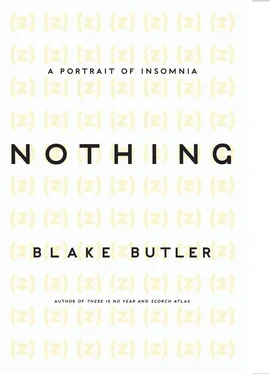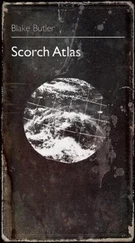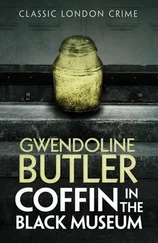Years later, I found my limb-frozen experience described by science as the hypnopompic state — a branch “of consciousness leading out of sleep… emotional and credulous dreaming cognition trying to make sense of real world stolidity.”130 The term emotional here is particularly compelling, in that it touches on an element of my particular dream’s recursion that might not manifest itself directly on its face. In placing myself back in my body in that vision — which I find myself capable of doing without much of any interference — and allowing the image in me again to grind on, I feel a kind of calm but manic feeling coursing through me: a sense of immense stillness combined with a low, unwinking doom. The sensation of my impending demolition under the boulder’s weight is not so much a threat or fury, but an eternal, pervading frame, as if all time held passed inside the moment and time to come could exist there in the hung present, nowhere, all sound and no sound, beyond death. In relief to each hour right now where I sit typing, and the rooms tonight where I will be when I move from one into the next, that space of being beneath the boulder remains exquisite, each instant of the nothing turned up so loud and wanting in me that to walk outside it into days makes what goes on around my flesh seem that much less real, obscuring memory and bodily function in dereference to the context of such light — eternity in the nowhere versus here-I-am-again today, in this old home whose walls go on and on without me, and outside it there, the world.
The result, if one allows it, is a kind of supercharging of any hour. Each instant of our being, eating, seeing, walking, wanting, is surrounded, consciously or unconsciously, by what we’ve hid inside ourselves, by where the dreamworlds we would have lived on and on inside forever if we could have go on without us — we locked inside our bodies out here without a clear door. The rooms where one is everyday, then, might seem foreign, or as strangers, a place you are because you are, and not because you ever really wanted, and they know. They hear you think. They have no arms or action to take against you, but they can hear your body, and they respond by being, going on, while you — you come and go again and again until you can’t. Your home, in its long silence, maybe more than any other knows always exactly who you are, who you’ve been, and who you will be, what you have and have not done — and therein, in each day’s eventual returning to the sleep field where the house is most alive, a kind of unconscious accruing of another kind of hidden, silent light that makes sleeping and waking seem to blur, to become closer to one another between hours, disrupting time inside of time.
That I am writing these sentences in the same bedroom where this dream came for me seems only fitting — that old bedroom now converted in my parents’ house to a makeshift office where I come most days to be around to help my mother care for my father in his dementia — a constantly degrading state in which he less and less can recognize his surroundings or himself and how to move within it as he had — though no matter how hard I try, the ceiling of the room here now is just short and flat and white. There is nothing visibly disrupted in it. The nightglow stars have been removed. The walls, having been painted over purple and populated with my mother’s things, are different enough that the room itself seems not that room from back then here at all — though in the air, the presence, I can feel it, I’d rather not let it know I do.
]
]
]
Once an awareness of the silent terror of selves in sleeping rooms and rooms inside of sleep is activated, it can be tricky to turn off. The fear of sleeplessness breeds more sleeplessness, and the locks begin to change around the keys, the mind turning activated inside a tired body, full of no distinct direction. The air of what wants out or on inside the head in growing tired and staying tired makes days seem brighter, thicker. The house around the self might seem to grow. Walls of rooms that might have been in spots before for so long might seem shifted slightly to the left, or of another color, gone. As well, in context with the body, the skull might seem thicker made around the eyes, or softing. The pupils set just deeper in the head now, new fat black edges around the seen. One might feel degrees warmer inside one’s self, though the skin itself is as any day, as if cooking too deep beneath the outer surface to be detected. The head may seem sunken in itself, unseen layers laid over layers, like a helmet or a gown. Early on, especially, it can be difficult to decipher the unslept person from the other as there is little visible physical effect but in the face or around the eyes, and who, these days, does not look worn out? We need not to have not slept to seem some way destroyed, as there is enough air to be packed in or at or against any body to cause the body to decay. We know.
What do we know? As here, in speaking, too, the voice feels deeper set within one, heavy, rubbed with charcoal, not quite mine . This speech is often stuttered, skewed with burps of repetition or false replications of familiar sound. Suddenly, the light of words that had sat forever in their pattern, without question — one’s name, for instance, or the numbers directed to dial through phones into one’s house — begin, as with relentless repetition, to seem arbitrary, blank — sound carved out of nothing, hieroglyphic, shells. The voice from deep within one’s self, set lodged there, of an other, toned out through the lengthy corridors of skin. The speech, particularly in passing into others, might not come out as you’d meant, or even at all, in the range or urge of your intention for standing in a room. Contact with bodies is someone else’s. Machines learn to trick you. Lights are loud — and the night, its saddened trick like someone placing a blanket over the cage in which for all these years you’ve been, inside yourself, corralled — room to room to room forever, mazes in a map, inside a video game made of air and buildings, no beginning and no end.
The default thought in light of all this, again, is to try to think of nothing. We are told, in sleep trouble studies, to try to clear our mind, to feel the stress and ideas pouring down out of our body. Silence. You’re supposed to let everything go. The idea of thinking of nothing then quickly becomes the thought of trying to think of nothing, and the thought of that, and that. So begins the landslide, as to think of nothing is to think of everything at all. White space screams, “Complete me.” Silence waits for how it will be filled. The very expectation of this nowhere coming on in definition works harder than any particular thing itself, filling around the want of blank with a hot vacuum, magnetizing mind.
In “Nothing: A Preliminary Account,” Donald Barthelme approaches nothing’s endless explanation by presenting a list of things nothing is not. “It’s not the yellow curtains. Nor curtain rings. Nor is it bran in a bucket, not bran. ..” The list goes on in loops of undefinition, hurrying itself forward to pack in more and more of nothing in the short remainder of our time, until soon, pages later, at all points failing to complete the list, it finds itself speaking of itself: “But if we cannot finish, we can at least begin. If what exists is in each case the totality of the series of appearances which manifests it, then nothing must be characterized in terms of its non-appearances, no-shows, incorrigible tardiness. Nothing is what keeps us waiting (forever).” The elucidation ends, again, opening unto identity via blank, here made ominous in the knowledge that before any kind of such expectation could be completed, the duration of our lives here must end, which Barthelme again negates in his final iteration, “Nothing is not a nail.” So here again is endless branching, reaching unto nothing and finding exactly that over and again where it is not, and again we feel exhausted and have gone nowhere, though perhaps in the meantime we have bumped up against some light.
Читать дальше












